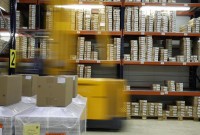- Home
- Business Processes
- Industry Knowledge
- Aerospace Industry
- Automotive Industry
- Banking Domain
- BFSI Industry
- Consumer/ FMCG Industry
- Chemicals Industry
- Engineering & Construction
- Energy Industry
- Education Domain
- Finance Domain
- Hospitality Domain
- Healthcare Industry
- Insurance Domain
- Retail Industry
- Travel and Tourism Domain
- Telecom Industry
- Leadership Skills
- eLearning
- Home
- Business Processes
- Warehouse Management
- Different Types of Warehouses
Different Types of Warehouses
Warehouses may seem like a simple, straightforward concept, but they actually include a variety of different types of warehouses that all have their own niche. The type of warehousing that’s right for you depends on your specific industry, location, and needs. From private warehousing, distribution centers, and climate-controlled warehouses, there’s an option to suit every business.
Warehouses may seem like a simple, straightforward concept, but they actually include a variety of different types of warehouses that all have their own niche. The type of warehousing that’s right for you depends on your specific industry, location, and needs. From private warehousing, distribution centers, and climate-controlled warehouses, there’s an option to suit every business.
Distribution Center
Distribution centers are warehouses where goods are stored temporarily. In these warehouses products are received from suppliers, sorted and packed and then rapidly shipped out to customers. An example of a distribution center is a warehouse that handles perishable products. They will receive shipments in the morning and distribute them by the end of the same day.
Private Warehouse
These warehouses are privately owned and generally used by retail corporations or engineering companies to store their inventory.
Public Warehouse
Public warehouses can be leased to companies with short-term distribution needs. For example, retailers with their own private warehouse may seek out additional storage space at a public warehouse just to keep surplus of inventory for a short while. Once spaces free up in their own warehouse, they’ll discontinue the use of the public space. Private warehouses will have higher fixed costs but lower unit operating costs, whereas the public warehouses will potentially cost you higher in terms of variable costs.
Automated Warehouse
Automated warehouses are, nearly completed automated. With very little manpower required for supervision, these warehouses operate using the latest software technology, cranes, and carriers to maintain and carry out their duties.
Climate-Controlled Warehouse
Warehouses store many different products, often including those that need to be kept at a specific temperature. Items that require special handling conditions should be kept in a climate-controlled warehouse. This can range from freezing temperatures to keep frozen products in tact to humidity-controlled environments for delicate botanical products and even dirt-free facilities to keep sensitive computer equipment safe. Moreover, they are control environments to ensure desired quality and usability with humidity, microorganism prevention mechanisms.
Retail Warehouse
Retail warehouses are stores dealing in consumer goods that are operated in single-level buildings. Generally, they are limited to 1000 square meter retail spaces. The floor space is mostly majorly allocated to sales with some of the space also being utilized for back office and storage purposes.
Fulfillment Warehouse
Fulfillment warehouses are third-party warehouses used by e-Commerce companies to control costs and manage strategic benefits. The products are lifted from the seller site and stored here until they are dispatched for delivery after processing.
Hazmat Warehouse
This is an abbreviation for the Hazardous Materials Warehouse which is designed to safely store chemicals and physically dangerous substances. It also includes radioactive and biologically dangerous materials. Special provisions are made because these substances can damage their surrounding environment and put lives at risk. In cases of Hazmat warehouses, compliance is also a primary factor in design. Government agencies are involved to ensure safety at such sites.
Overseas Warehouses
These warehouses are catered for the overseas trade. In cross-border trade e-commerce, overseas warehouses refer to domestic enterprises transporting commodities to target market countries through bulk transportation, establishing warehouses and storing commodities locally, then, according to the local sales order, the one-stop control and management service of sorting, packaging and distribution will be carried out directly from the local warehouse in a timely manner.
Packing Warehouses
The main purpose of packing warehouses was the picking, checking, labelling and packing of goods for export. Railway Warehouses These warehouses were built close to the major stations in railway hubs.
Canal Warehouses
Canal warehouses were used for trans-shipment and storage.
Related Links
You May Also Like
-
Warehouse management and distribution logistics involve the physical warehouse where products are stored, as well as the receipt and movement of goods takes place. Warehouse management aims to control the storage and movement of products and materials within a warehouse. These operations include the receipting of inwards goods, tracking, stacking and stock movement through the warehouse.
-
Resource Planning is the process of planning for expected workload and determining the number of resources required to complete each activity in the warehouse. There are many types of warehouse positions, and they also vary by the employer, the scale of operations and location. Discussed here are generic positions applicable to warehouse management processes.
-
Warehouses may seem like a simple, straightforward concept, but they actually include a variety of different types of warehouses that all have their own niche. The type of warehousing that’s right for you depends on your specific industry, location, and needs. From private warehousing, distribution centers, and climate-controlled warehouses, there’s an option to suit every business.
-
Before shipping, businesses need to make sure that the items will arrive in good condition. Packaging is a form of protection against environmental threats that the product will face from the time it leaves warehouse facility until the time it reached the customer. The packaging is intended to provide protection for the item as it is being handled in the warehouse or when the item is being shipped.
-
Overview of Warehouse Processes
The basic function of a warehouse is to store goods. This means that they receive deliveries from suppliers, do any necessary checking and sorting, store the materials until it is dispatched to customers. Traditionally warehouses were seen as places for the long-term storage of goods. Now organizations want to optimize their customer experience and try to move materials quickly through the supply chain, so the role of warehousing has changed.
-
Miscellaneous Warehouse Processes
At the end of each inventory control, the Contractor provides the Ordering Person with an inventory report which contains a list of all stock adjustments. The Ordering Person uses the report to create, by use of his/her own means, necessary value and accounting adjustments related to the stock. Let us look at some to the mislaneous warehouse processes not covered earlier.
-
To stay competitive in today’s tough market, the location of your warehouse is vital. To grow retail business need to offer to customers faster and affordable shipping time, which is dependent on the warehousing location as the location of the warehouse affects the transit time to ship orders to customers.
-
Warehouses can be places where piles of packed or loose products occupy space. If left disorganized, it will become very challenging to identify products for packing or picking. Hence, proper organization of warehouse is very important. Warehouse labeling systems eliminate this problem by making sure products are easily identified and managed during the warehousing and shipping process. Labeling is the most functional and cost-effective way to keep your warehouse organized and operating efficiently.
-
In the normal course of business, customers are likely to return orders from time to time due to various reasons and business should design processes the manage and accept such returns. A well designed returns management process can reduce costs and issues associated with returns or exchanges.
-
After products have been received and passed a quality inspection, they need to be stored so that you can find them when you need them. This process is called putaway. The spot where you store a particular product is called a location. One section of a warehouse might have small locations for light items; another area may have large locations on the floor for heavy items.
Explore Our Free Training Articles or
Sign Up to Start With Our eLearning Courses

About Us
Learning
© 2023 TechnoFunc, All Rights Reserved











